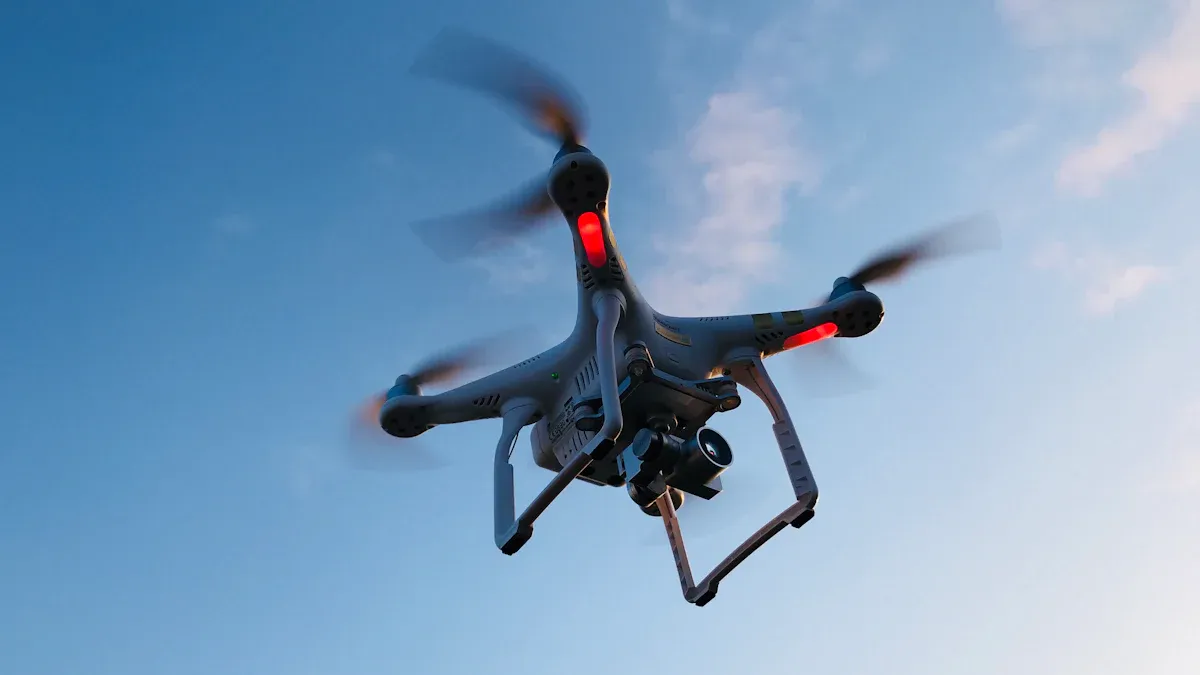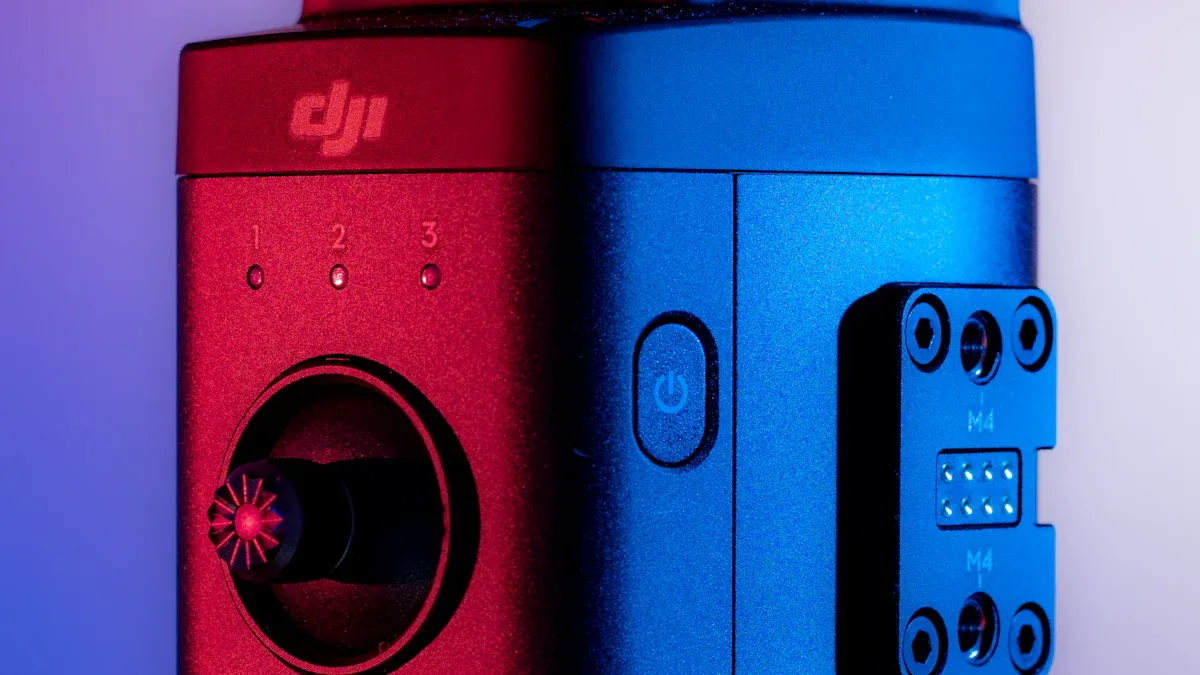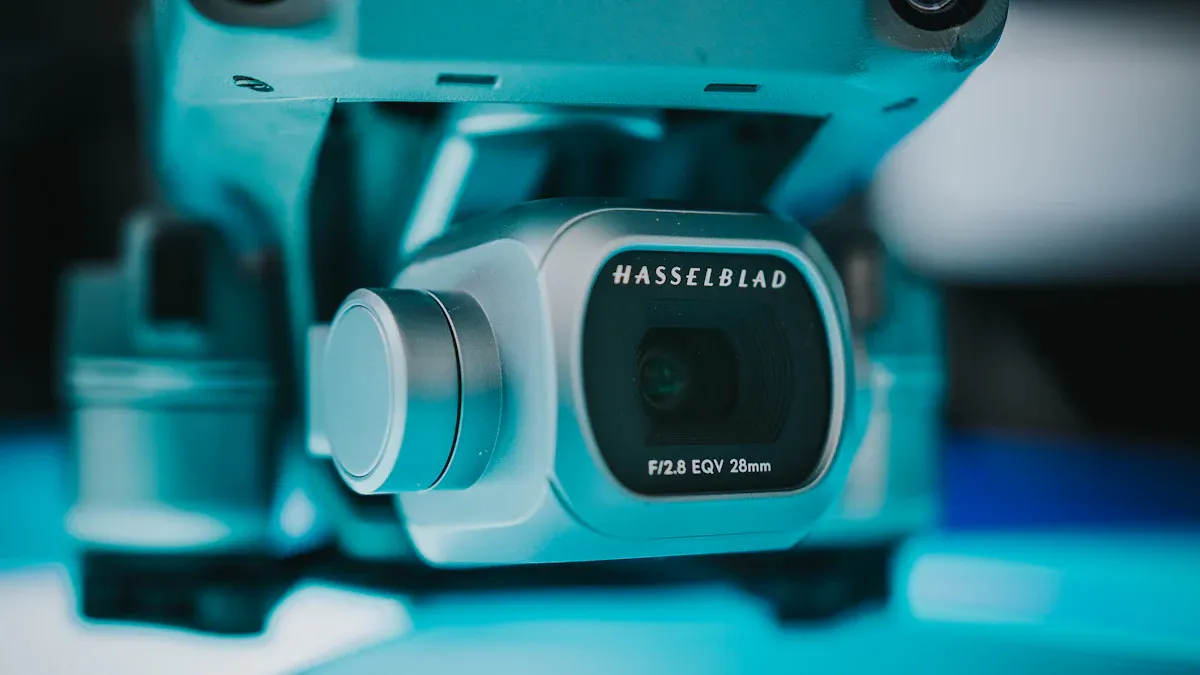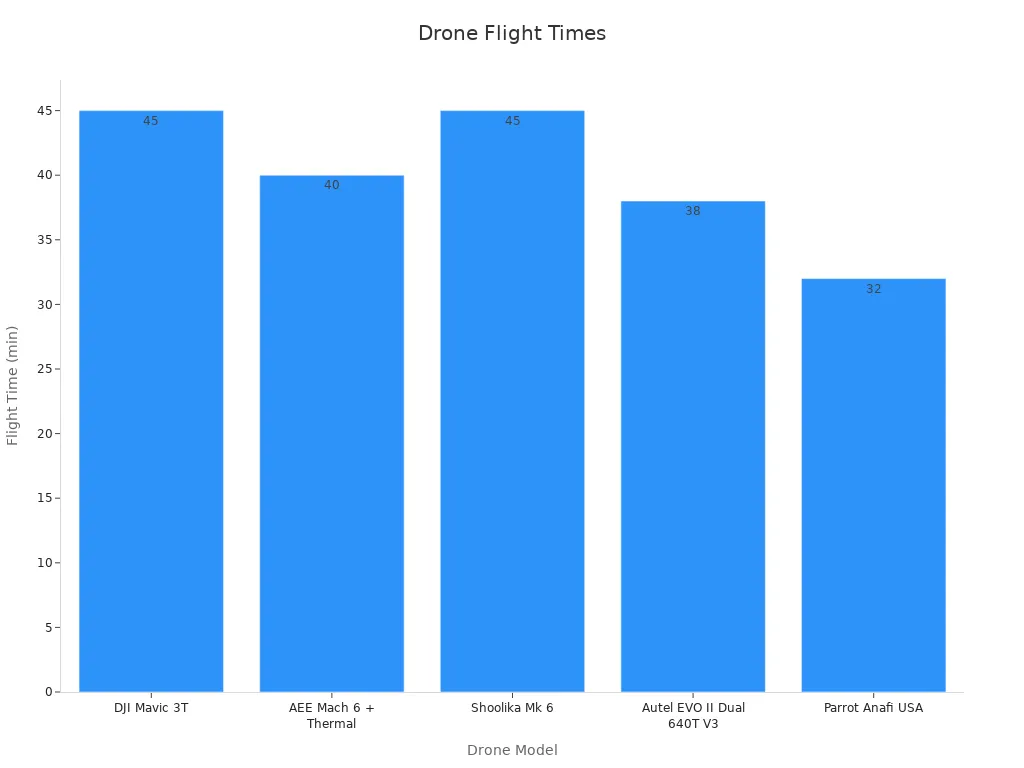
Industry experts think the 640×512 resolution will do better than 320×256 in drone thermal imaging for 2025. The drone analytics and civil drone markets are growing fast. This shows more people want better thermal imaging. Drones like the DJI Matrice 350 RTK and Autel EVO Max 4T use 640×512 sensors. These sensors give clearer pictures and let you see more area. Picking the right resolution is important. More pixels help drones work safer and more accurately. This is key for thermal inspections, search and rescue, and other important jobs. People should pick the best thermal drones in 2025 for their own needs to get the best results.
Drone Model | Thermal Resolution | Field of View (°) | Key Features & Applications |
|---|---|---|---|
DJI Matrice 350 RTK | 640×512 | 40.6 | High frame rate, modular sensors, firefighting, inspection |
Autel Robotics EVO Max 4T | 640×512 | 56 | Digital zoom, long flight, law enforcement, agriculture |
Parrot Anafi USA | 320×256 | 50 | Zoom, security, disaster response |
Yuneec H520E RTK | 320×256 | N/A | Dual camera, surveying, mapping |
Key Takeaways
Drones with 640×512 thermal cameras show clearer pictures. They can find small heat changes better than 320×256 models. This makes them great for rescue and inspection jobs.
Picking the right thermal resolution depends on what you need. It also depends on how much money you have. 320×256 sensors are good for beginners and easy jobs. 640×512 sensors are better for hard jobs that need clear views.
High-resolution thermal drones help spot heat problems early. They can check big areas safely. They work well in the dark or in tough places. This helps missions succeed.
Professional drones have better sensors and fly longer. They cost more money. But they last longer and have smart features. They can be changed for different jobs.
The drone thermal market is growing fast. New models have better pictures and fly longer. They are easier to use. This helps more people use thermal imaging.
Resolution Basics

640×512 vs. 320×256 Explained
Thermal imaging cameras use infrared to show heat differences. The numbers 640×512 and 320×256 are the sensor’s pixel counts. More pixels let the camera show more details in each picture. This matters when you need to spot small things or check temperature changes from far away.
The table below lists the main technical parts that affect how thermal sensors work in infrared imaging:
Parameter | Description | Impact on Resolution Basics and Thermal Imaging |
|---|---|---|
IR Resolution | Number of pixels in the thermal image | More pixels give clearer images and better accuracy, which helps with small or faraway targets. |
Thermal Sensitivity (NETD) | Smallest temperature difference the camera can detect | Lower NETD means the camera can spot tiny heat changes, which is important for detailed pictures. |
Field of View (FOV) | How much of the scene the lens can see | This changes how much you can see and from what distance, which affects the picture’s details. |
Spectral Range | The range of wavelengths the sensor can detect (in micrometers) | This decides what jobs the camera is good for and what kind of heat it can sense. |
Temperature Range | The range of temperatures the camera can measure | This makes sure the camera can read the heat in the area you want to check. |
Focus Type | Fixed, manual, or automatic focus | This changes how clear the picture is and how well the camera measures heat, which is important for good results. |
Other things, like quantum efficiency and signal-to-noise ratio, also change how well a thermal sensor works. Sensors with high quantum efficiency and low noise make clearer pictures, even when it’s dark or hard to see. These things help people get the best results from high-resolution thermal cameras.
Impact on Drone Thermal Imaging
Resolution is very important for drone thermal imaging. High-resolution sensors, like 640×512, let people see small details and tiny temperature changes. This helps a lot with jobs like search and rescue, checking power lines, and farming.
Tests in labs show that high-resolution infrared cameras, like the Teledyne FLIR T1K, can find small heat changes and air movement when drones fly fast. These tests show why good thermal resolution is needed for collecting and studying data. In farming, scientists learned that the right sensor resolution, lens, and flying height give the best temperature readings and picture quality.
Drone thermal imaging works better when the sensor settings are just right. The best sensor, lens, and flight plan help both experts and beginners get good results. As technology gets better, more drones will have advanced sensors that work well in real situations.
Key Differences
Image Quality
Image quality is very important in thermal imaging. Cameras with higher native resolution, like 640×512, show sharper and clearer images than 320×256 models. You can see this difference when looking at small temperature changes or far away things. High-resolution cameras help people find small heat spots. This is very helpful for night vision drones in rescue or checking buildings.
Note: Native sensor resolution is more important than upscaled output. Upscaling can make pictures look nicer, but it might make measurements less reliable, especially for careful jobs.
The table below compares some devices. It shows how native resolution and image processing change image quality and temperature stability:
Device | Native Resolution (px) | Output Resolution (px) | Temperature Stability Over 10 min | Spatial Uniformity & Image Quality Notes |
|---|---|---|---|---|
FLIR One Pro | 160 x 120 | 640 x 480 (upscaled) | Median temperature increase of 2 °C | Uses MSX upscaling; higher temperature variation; image modification may reduce reliability in sensitive applications |
Seek Thermal CompactPRO | 160 x 120 | 1280 x 960 (upscaled) | Median temperature drop of 4 °C | Best spatial uniformity; upscaling improves resolution but may introduce uncertainty |
Hikmicro | 160 x 120 | 160 x 120 (native) | Most stable temperature readings | No upscaling; lower resolution may limit precision but offers stable and reliable measurements |
Night vision drones with 640×512 sensors give the clearest pictures for dark and infrared work. These sensors help people find small animals, people, or tools, even in tough places.
Detection Range
Detection range means how far a thermal sensor can find heat. High-resolution sensors, like 640×512, can see farther than 320×256 models. This is very important for rescue teams who need to find missing people in big areas or for workers watching large fields at night.
A study at a Belgian wind farm shows that detection range depends on sensor resolution and the environment. It gets harder to find things as they get farther away, especially when it is noisy or dark. If you check every day instead of every hour, the detection range can go up by 266 meters. This means night vision drones with high-resolution sensors can stay accurate over longer distances, even if things change.
People who use drones for rescue or animal watching like the longer range and better results from high-resolution cameras. These drones work well in dark and infrared situations, so they are the best for hard jobs.
Price and Value
Price and value are important when picking a drone thermal camera. In the last ten years, drone prices dropped because making them got cheaper and technology got better. Starter night vision drones with simple thermal features now cost less than $1,000. High-end models with advanced sensors and high resolution cost more, but they work better for pros.
Resolution (pixels) | Example Models | Image Quality & Features | Price/Value Insight |
|---|---|---|---|
80 x 60 | Flir C2, Flir E4, Fluke TiS10 | Basic thermal resolution; enhanced by MSX image contrast technology; Flir E4 can upscale to 320 x 240 px | Entry-level, respectable quality under $1000 |
160 x 120 | Milwaukee M12, Fluke Ti110 | Moderate resolution; software features like IR Fusion improve image blending and guidance | Mid-range devices with better detail |
320 x 240 | Flir E60 | High resolution with built-in MSX enhancement; delivers phenomenally good thermal image quality | Higher price, superior image detail |
The table above is about handheld devices, but drone cameras follow the same pattern. Higher resolution and more features make the price go up, but they also make the camera work better in the dark and for rescue jobs. People should think about what they need and how much they can spend to get the best deal.
Use Cases
Different jobs need different thermal sensor resolutions. Night vision drones with 640×512 sensors are best for pro rescue, firefighting, and checking buildings. These jobs need high-resolution images to see small heat changes and work in the dark. Operators can cover big areas fast and find targets more easily.
For beginners or people on a budget, 320×256 sensors are a good mix of price and performance. These drones are good for simple checks, animal watching, and easy rescue jobs in less tough places. They work well in most dark situations, but might miss smaller or farther targets.
Tip: Always pick the right thermal sensor and resolution for the job. High-end drones with advanced sensors give the best results for hard work, while cheaper models are fine for easy jobs.
Night vision drones keep getting better as companies add new sensors and stronger infrared features. The best drone thermal cameras in 2025 will have choices for everyone, from pros to hobby users.
Best Thermal Drones in 2025

Top Picks Overview
In 2025, there are many thermal drones for different people and jobs. Big brands like DJI, Autel, Teledyne FLIR, and Parrot have new models. These drones are known for being strong and working well. Experts picked the best ones by looking at their sensors, how long they fly, and special features.
The DJI Mavic 3T is a top choice for careful work. It has a 640×512 sensor and can fly for 45 minutes. People use it for rescue, checking power lines, and security.
The DJI Matrice 30T and Matrice 350 RTK with Zenmuse H30T are for pros. They are tough, have IP55 weather protection, smart AI, and avoid obstacles. They are great for fighting fires, checking buildings, and flying at night.
The Autel EVO Max 4T is easy to carry and powerful. It has a 640×512 sensor and flies for a long time. Police and farmers like to use it.
The Teledyne FLIR SIRAS can change its parts for different jobs. This modular drone is good for factories and public safety.
The Parrot Anafi USA and Yuneec H520E are light and made for government use. They use 320×256 sensors and are easy to use. They help with disaster work and watching animals.
Note: Experts like Advexure say these drones are useful for many jobs. They help police, firefighters, rescue teams, and people who check power lines.
The table below shows the main features of the best thermal drones in 2025. It lists their sensor resolution and what they are best used for:
Model | Sensor Resolution | Flight Time (min) | Durability/Rating | Key Applications |
|---|---|---|---|---|
DJI Mavic 3T | 640×512 | 45 | IP43 | Search and rescue, inspection, security |
DJI Matrice 30T | 640×512 | 41 | IP55 | Firefighting, infrastructure, night ops |
DJI Matrice 350 RTK | 640×512 | 55 | IP55 | Utilities, mapping, rugged enterprise |
Autel EVO Max 4T | 640×512 | 42 | IP43 | Law enforcement, agriculture |
Teledyne FLIR SIRAS | 640×512 | 31 | IP54 | Modular missions, industrial, public safety |
Autel EVO II Dual 640T | 640×512 | 38 | IP43 | Inspection, search and rescue |
Parrot Anafi USA | 320×256 | 32 | IP53 | Disaster response, wildlife, lightweight government-grade |
Yuneec H520E | 320×256 | 28 | IPX4 | Mapping, surveying, entry-level |
Skydio X10 | 640×512 | 40 | IP54 | Security, infrastructure, best modular |
Autel EVO Lite Enterprise | 320×256 | 40 | IP43 | Entry-level, security, night vision |
These top thermal drones in 2025 have strong cameras and fly well. You can pick different sensors or change parts for many jobs. They work for rescue at night or tough jobs in bad weather.
Professional vs. Budget Options
Professional thermal drones are the best for hard jobs. Models like the DJI Matrice 350 RTK, Autel EVO Max 4T, and Teledyne FLIR SIRAS have 640×512 sensors. They use smart image tools and fly for a long time. These drones are made for rescue, firefighting, and checking big buildings. They are strong and can handle bad weather.
Cheaper drones like Parrot Anafi USA, Yuneec H520E, and Autel EVO Lite Enterprise are easy to use. They use 320×256 sensors and do not fly as long. These are good for beginners, watching animals, and simple night work.
The table below compares pro and budget thermal drones using important points:
Benchmark Category | Professional Thermal Drones | Budget Thermal Drones |
|---|---|---|
Sensor Resolution | 640×512 pixels for detailed thermal imaging | 320×256 pixels or lower |
Thermal Sensitivity | NETD below 50 mK for subtle temperature differences | Higher NETD, less sensitive |
Image Processing | Advanced (PIP, MSX overlay, radiometric) | Limited or basic |
Flight Time | 30–55 minutes, hot-swappable batteries | 20–40 minutes, fixed batteries |
Control Range | 5–20 km | Below 5 km |
Build Quality | IP54–IP55, rugged enterprise thermal drone construction | Lower IP ratings, less durable |
Payload Versatility | Modular, supports multiple sensors | Fixed or limited payloads |
Professional drones are the best modular thermal drone choices. You can change sensors and cameras for different jobs. This makes them worth the money over time. Budget drones are cheaper and good for simple jobs.
Tip: Think about what you need, your budget, and how often you will use the drone. Expensive drones cost more at first but last longer and do more. Cheaper drones are good for easy jobs and save money.
Reviews show that the best thermal drones in 2025 save money and keep people safe. You can add new parts or use AI for more jobs. The best precision thermal drone models are great for rescue. Light government-grade thermal drones are good for quick help teams.
Night vision drones keep getting better. They now have clearer pictures, fly longer, and are stronger. The best modular thermal drone models let you change parts for new jobs. This makes them a smart buy for the future.
Drone Thermal Reviews and Trends
User Feedback
People who use thermal drones in 2025 have shared many reviews. Most say that good thermal imaging and easy controls are very important. Workers in public safety and inspection need drones that show clear thermal images in the dark. They say night vision drones with 640×512 sensors give sharper pictures and can see farther. Many people like drones that can fly by themselves and follow targets. These features make missions safer and faster. Real-life stories often talk about how these drones help teams search big areas quickly, especially at night.
A lot of users think that drones must have self-flying and good low-light features now.
Hobbyists and beginners want drones that are simple to use and not too expensive. They usually pick models with 320×256 sensors for basic thermal jobs. These users say that automatic takeoff, landing, and avoiding things make flying safer, even for new pilots.
Market Trends
The drone thermal market is changing quickly. Companies now add both thermal and regular cameras to drones. This makes pictures clearer and helps people see better in the dark. Smaller and changeable designs make it easier to put thermal cameras on drones. This meets the need for small and flexible drones.
Recent numbers show that more drones can carry 2KG to 19KG, which often means they have thermal cameras. This is because more people use drones for safety, emergencies, and disaster help. Renting or subscribing to drones is getting popular. This makes high-tech drones cheaper and easier for more people to use.
New products, like the Autel Alpha drone, have two thermal sensors and smart flying tools. These new drones can fly by themselves, work well in the dark, and are very strong. Smart features, like real-time data and automatic reports, help people finish hard jobs with less work.
Choosing the Best for Your Needs
Professional Applications
People who work in utilities, public safety, and engineering need top thermal drones for hard jobs. They often pick drones with 640×512 sensors to get clear pictures for search and rescue or firefighting. The best drones for these jobs have both thermal and RGB cameras. This lets them show heat and normal images together for better checks. Drones with steady flying, GPS, and obstacle sensors help keep missions safe. A battery that lasts at least 30 minutes is needed to cover big areas. This is very important for emergencies.
Criteria | Professional Standard |
|---|---|
Thermal Resolution | 640×512 px preferred for detailed imaging |
Camera Integration | Thermal + RGB overlay for context |
Flight Time | 30–55 minutes |
Software Compatibility | Advanced analysis and reporting tools |
Portability | Foldable, weather-resistant designs |
Autonomous Features | Obstacle avoidance, GPS, AI inspection |
Professionals should think about rules, weather, and privacy before picking a drone.
Many experts say drones like the DJI Matrice 300 RTK and Autel EVO Max 4T are great choices. These drones work well in the dark and during emergencies. They can fly by themselves, measure heat, and go far. Real tests show drones with better sensors and longer flying times do best for rescue and checking buildings.

Entry-Level and Budget Choices
Entry-level and budget thermal drones help new users and small teams get important features without spending too much. These drones usually use 320×256 sensors, which work well for simple checks and watching animals. The best budget drones are easy to use, easy to carry, and have simple auto features like automatic takeoff and landing.
Cost Category | Estimated Range | Notes |
|---|---|---|
Initial Equipment | Entry-level starts at $800; advanced setups cost more | |
Software & Licensing | $500 – $2,000/year | Depends on software and storage needs |
Operator Training | $200 – $1,500 | One-time cost for effective operation |
Certifications | $75 – $200 | Covers pilot certificates and state fees |
Annual Operational Costs | $700 – $2,500 | Includes batteries, insurance, and maintenance |
A good expert guide says budget drones like the Parrot Anafi USA and Autel EVO Lite Enterprise give clear pictures in low light and have basic auto features. These drones are good for small emergency jobs, animal checks, and simple inspections. Buying used or fixed-up drones can save money, but people should check for a warranty and service records.
Tip: The best pick is one that fits your budget, running costs, and job needs. Entry-level drones may not have all the smart features, but they still help with night and emergency work for small groups.
The 640×512 thermal drones will probably be the top choice in 2025 for people who need to see small details and look far away. Drones like the DJI Mavic 3T and Autel EVO Max 4T have high resolution, good thermal sensitivity, and can fly for up to 45 minutes. These drones help users by giving:
Clear thermal images for careful jobs
Live data so people can decide quickly
Many uses, like search, rescue, and checking things
People who do not want to spend a lot may pick 320×256 models for simple watching. Everyone should pick a drone that fits their needs, what they want to do, and how much they can spend.
FAQ
What is the main advantage of a 640×512 thermal camera for drones?
A 640×512 thermal camera shows more details in pictures. This helps people see small heat changes and things far away. Professionals like rescue teams and inspectors pick this resolution for better accuracy and trust.
Can a 320×256 thermal camera meet most entry-level needs?
Yes, a 320×256 thermal camera is good for simple jobs. It works well for basic checks, watching animals, and easy searches. Many beginners and small groups choose it because it is not too expensive and works well.
How does sensor resolution affect drone battery life?
Sensor resolution does not change battery life by itself. But cameras with more pixels need more power to work. This can make the drone fly a little less time, but most new drones save power well.
Are thermal drones difficult to operate for new users?
Most thermal drones are easy to use and have auto flight modes. New users can learn how to fly them fast. Many drones have guides and safety tools, so beginners can use them without trouble.
See Also
The Importance Of Thermal Imaging Cameras In 2025
Using Thermal Imaging Cameras For Search And Rescue Missions
Vanadium Oxide Thermal Cameras Enhancing Rescue Operations
